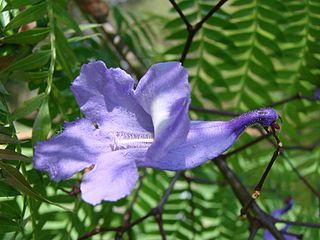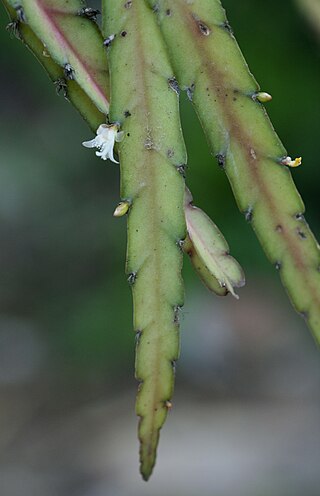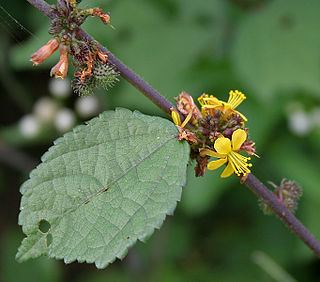
Zingiberaceae or the ginger family is a family of flowering plants made up of about 50 genera with a total of about 1600 known species of aromatic perennial herbs with creeping horizontal or tuberous rhizomes distributed throughout tropical Africa, Asia, and the Americas. Many of the family's species are important ornamental, spice, or medicinal plants. Ornamental genera include the shell gingers (Alpinia), Siam or summer tulip, Globba, ginger lily (Hedychium), Kaempferia, torch-ginger Etlingera elatior, Renealmia, and ginger (Zingiber). Spices include ginger (Zingiber), galangal or Thai ginger, melegueta pepper, myoga, korarima, turmeric (Curcuma), and cardamom.

Alpinia is a genus of flowering plants in the ginger family, Zingiberaceae. Species are native to Asia, Australia, and the Pacific Islands, where they occur in tropical and subtropical climates. Several species are cultivated as ornamental plants.

Jacaranda is a genus of 49 species of flowering plants in the family Bignoniaceae, native to tropical and subtropical regions of the Americas while cultivated around the world. The generic name is also used as the common name.

Sterculia is a genus of flowering plants in the mallow family, Malvaceae: subfamily Sterculioideae. Members of the genus are colloquially known as tropical chestnuts. Sterculia may be monoecious or dioecious, and its flowers unisexual or bisexual.

Lepismium is a genus of mostly epiphytic cacti, with seven species. They are found in tropical South America.

Bignonia is a genus of flowering plants in the family Bignoniaceae. Its genus and family were named after Jean-Paul Bignon by his protégé Joseph Pitton de Tournefort in 1694, and the genus was established as part of modern botanical nomenclature in 1753 by Carl Linnaeus. Species have been recorded from the southern USA, Central to most of South America.

Costus is a genus of herbaceous perennial plants in the family Costaceae, erected by Linnaeus in 1753. It is widespread through tropical and subtropical regions of Asia, Africa, and the Americas.

Hemigraphis is a genus of plants in the family Acanthaceae, consisting of 34 species native to tropical Asia. Hemigraphis is similar to plants the genus Strobilanthes, with some species now placed there. Its native range is Nansei-shoto and from Indo-China to New Guinea.

Leptactina is a genus of flowering plants in the family Rubiaceae. There are about 27 species. They are all native to sub-Saharan Africa, where most occur in rainforest habitat.

Corynanthe johimbe, synonym Pausinystalia johimbe, common name yohimbe, is a plant species in the family Rubiaceae native to western and central Africa. Extracts from yohimbe have been used in traditional medicine in West Africa as an aphrodisiac, called in some languages burantashi, and have been marketed in developed countries as dietary supplements.

Corynanthe is a genus of flowering plants in the family Rubiaceae.

Triumfetta is a genus of plants in the family Malvaceae. Burbark is a common name for plants in this genus.

Riedelia is a genus of plants in the family Zingiberaceae. The genus contains approximately 75 species that are distributed among New Guinea, the Solomon Islands, and Maluku Province in eastern Indonesia. Among the described species is Riedelia charontis, which was formally described in 2010.

Hermannia is a genus of flowering plants in the mallow family, Malvaceae. It comprises at least 65 species with many more species as yet unresolved.

Markhamia is a genus of flowering plants in the family Bignoniaceae; species are recorded from Africa and South-East Asia. The genus is named after Clements Markham.

Fockea is a genus of succulent scrubs native to Africa south of the equator. They are members of the Asclepiadoideae (milkweeds), a subfamily of the dogbane family Apocynaceae. Of the six recognized species, only the two most widely distributed extend north of southern Africa, with F. multiflora reaching as far north as Tanzania and F. angustifolia reaching to southern Kenya. Fockea are known as water roots, a reference to the bulbous caudex characteristic of most species, which is also edible in at least some species.

Afrocalathea is a genus of plants native to Africa. It contains only one species: Afrocalathea rhizantha (K.Schum.) K.Schum, known from Nigeria, Cameroon, Gabon, Cabinda, and Congo-Brazzaville.

Hornstedtia is a genus of plants in the Zingiberaceae. It is native to Southeast Asia, the Himalayas, southern China, New Guinea, Melanesia and Queensland.
Antiaropsis is a genus of flowering plants belonging to the family Moraceae. It is dioecious, with male and female flowers borne on separate plants.

Leptonychia is a genus of flowering plants belonging to the family Malvaceae.


















